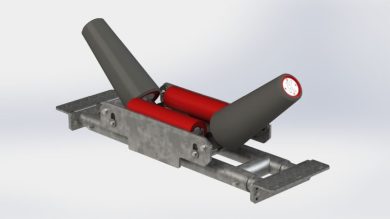Imagine a bustling automotive assembly line where sleek new cars are born. From the first spark of creativity to the final polish, every step in this process is a dance of precision and efficiency.
And right in the centre of this choreography? The unsung hero: conveyor belts. You might think of conveyor belts as simple machines, but they are nothing short of miraculous in automotive manufacturing.
Let’s dive into why conveyor belts Australia are essential in automotive assembly lines and how they keep the wheels of industry turning smoothly.
The Backbone of Automotive Production
Streamlining Production: The Magic of Conveyor Belts
In the fast-paced realm of automotive assembly, efficiency isn’t just a goal—it’s a necessity. Imagine trying to assemble a car without the magic of conveyor belts.
Chaos would reign! Conveyor belts transform this chaos into a seamless, synchronised operation.
They move components and parts through various stages of production with precision and speed, ensuring that each car progresses smoothly along the assembly line.
Conveyor belts are pivotal in maintaining the production flow, from delivering raw materials to distributing finished parts.
They eliminate bottlenecks and reduce the time it takes to move items from one workstation to another, making the entire process more efficient and less prone to human error.
Boosting Productivity: Speed Meets Precision
The automotive industry thrives on productivity. Every second counts and conveyor belts are designed to meet this challenge head-on.
By automating the transportation of parts, these belts minimise manual handling and allow workers to focus on more complex tasks that require human skill and judgment.
Imagine an assembly line where workers constantly run back and forth to fetch parts. Not only would this be time-consuming, but it could also lead to fatigue and errors.
Conveyor belts solve this problem by providing a continuous, steady flow of components, speeding up production and ensuring that every car is assembled precisely.
Reducing Costs: Efficiency Equals Savings
Cost control is crucial in automotive manufacturing, and conveyor belts Australia play a significant role in achieving this.
These belts reduce labour costs and minimise the need for expensive machinery by streamlining the assembly process.
They also help prevent damage to components by reducing the amount of manual handling required.
In addition, conveyor belts’ efficiency leads to shorter production cycles. This means manufacturers can produce more cars in less time, ultimately driving down per-unit costs and boosting profitability.
Investing in conveyor belts pays off through long-term savings and a more competitive edge in the market.
Enhancing Safety: A Safer Workplace for All
Minimising Manual Handling: Reducing Risks
Safety is paramount in any manufacturing environment, and conveyor belts contribute significantly to a safer workplace.
By automating the movement of parts and materials, these belts reduce the need for workers to engage in repetitive manual handling tasks.
This minimises the risk of injuries such as strains, sprains, and other musculoskeletal issues.
In addition, conveyor belts are designed with safety features like guards and emergency stop buttons, which help prevent accidents and ensure that workers can operate the machinery safely.
By investing in conveyor belts, automotive manufacturers are enhancing efficiency and prioritising the health and well-being of their workforce.
Ensuring Consistency: Quality Control at Its Best
Consistency is key in automotive manufacturing. Every car needs to meet stringent quality standards, and conveyor belts Australia help maintain this consistency.
These belts provide a stable and reliable means of transporting components, reducing the likelihood of errors and defects.
With conveyor belts, manufacturers can implement quality control measures at various stages of the assembly line.
For example, inspectors can easily check for defects or issues as the parts move along the belt, allowing quick corrections and adjustments.
This proactive approach to quality control helps ensure that every car meets the highest standards before it leaves the factory.
Innovation and Future Trends: The Evolution of Conveyor Belts
Smart Conveyor Systems: The Future Is Now
The world of conveyor belts is not static; it’s evolving with technological advancements. Innovative conveyor systems are at the forefront of this evolution, integrating sensors, automation, and data analytics to enhance efficiency and productivity further.
These advanced systems can track component progress, monitor belt performance, and even predict maintenance needs.
By leveraging real-time data, manufacturers can optimise the assembly process, reduce downtime, and ensure that the production line operates at peak performance.
Sustainable Solutions: Green Conveyor Technologies
As the automotive industry approaches sustainability, conveyor belts adapt to meet these goals. Eco-friendly conveyor technologies are being developed to reduce energy consumption and minimise environmental impact.
For instance, energy-efficient motors and low-impact materials make conveyor belts more sustainable.
These innovations help manufacturers reduce their carbon footprint and align with the broader industry trend towards greener practices.
The Bottom Line: Why Conveyor Belts Are Indispensable
In the high-octane world of automotive manufacturing, conveyor belts Australia are more than just a piece of equipment—they are the lifeblood of the assembly line.
They streamline production, boost productivity, reduce costs, enhance safety, and drive innovation.
Without them, the efficient and precise manufacturing of cars would be nearly impossible. So, the next time you see a shiny new car rolling off the assembly line, remember that it’s not just the result of cutting-edge technology and skilled craftsmanship.
It’s also thanks to the humble but mighty conveyor belt—an essential component that keeps the wheels of automotive manufacturing turning smoothly.
In the ever-evolving landscape of automotive production, conveyor belts are proving that the simplest tools can sometimes have the greatest impact.

